Key Points:
- 3,500 species of snake exist on the planet, 600 of which are venomous.
- Venomous snakes range in size from tiny to quite large.
- The largest venomous snake can grow up to 18 feet in length.
Snakes are fascinating reptiles that come in a wide range of sizes and inhabit a wide range of habitats worldwide. Unfortunately, because some of them are venomous, they terrify many people. Of about 3,500 different kinds of snakes on the planet, around 600 are venomous. Most of them do not attack humans unless they are in danger and have no way to flee. However, it’s natural to wonder what the world’s most venomous snakes are because they are the ones you want to avoid. Venomous snakes exist in a variety of sizes. Some of the world’s deadliest snakes can grow to astonishing lengths and weights, making them even more terrifying. In this article, we will explore the 12 largest venomous snakes in the world.
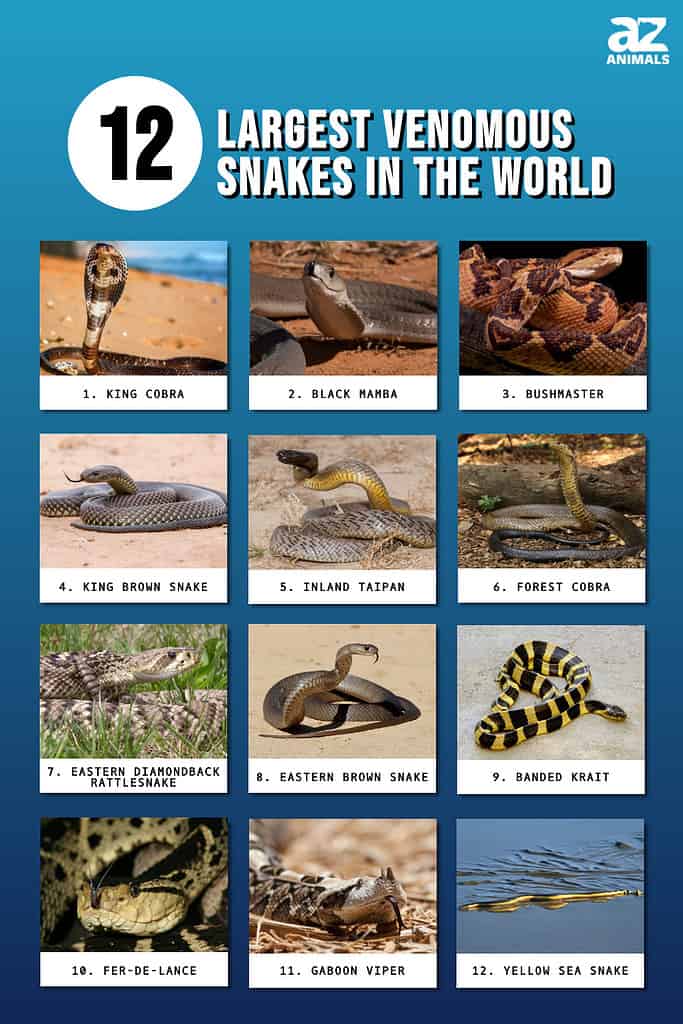
12. Yellow Sea Snake
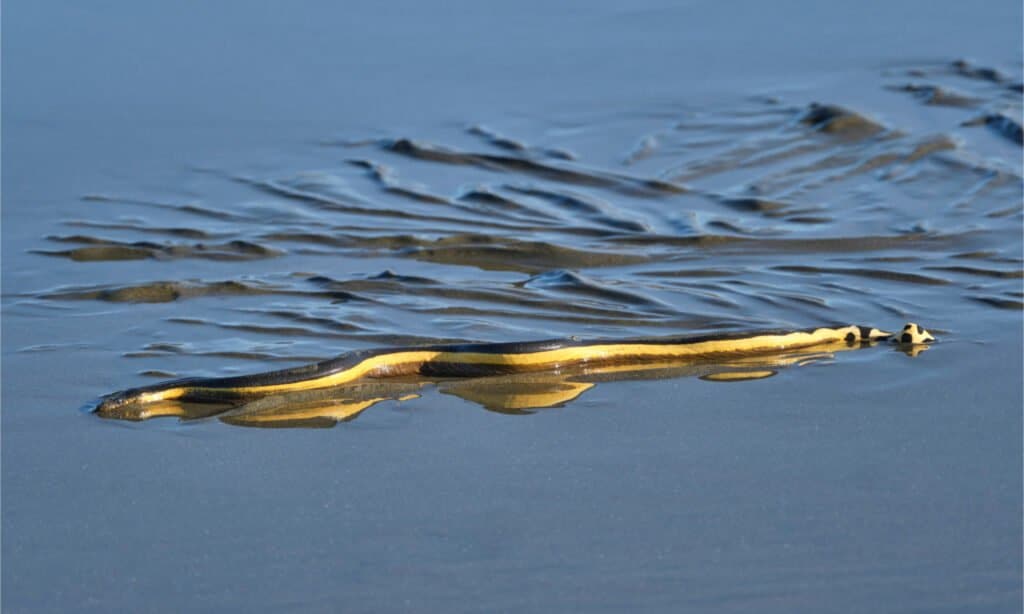
The yellow-bellied sea snake is the world’s longest venomous sea snake.
©John Fader/Shutterstock.com
Although reports say that these species can grow to an estimated length of 9 feet, most of the specimens caught are often 3 feet long. The yellow sea snake is the world’s longest venomous sea snake, measuring between 3 and 5 feet. It is a member of the Elapidae family, which makes it closely related to cobras, kraits, coral snakes, king cobras, and many Australian species. This snake can be found on dark, sandy ocean floors and live up to 164 feet (50 meters) beneath the water’s surface, feeding largely on eels. Yellow sea snakes can be found in the northern Indian Ocean, New Caledonia, and Southeast Asia, such as the Philippines, and New Guinea, among other places.
11. Gaboon Viper
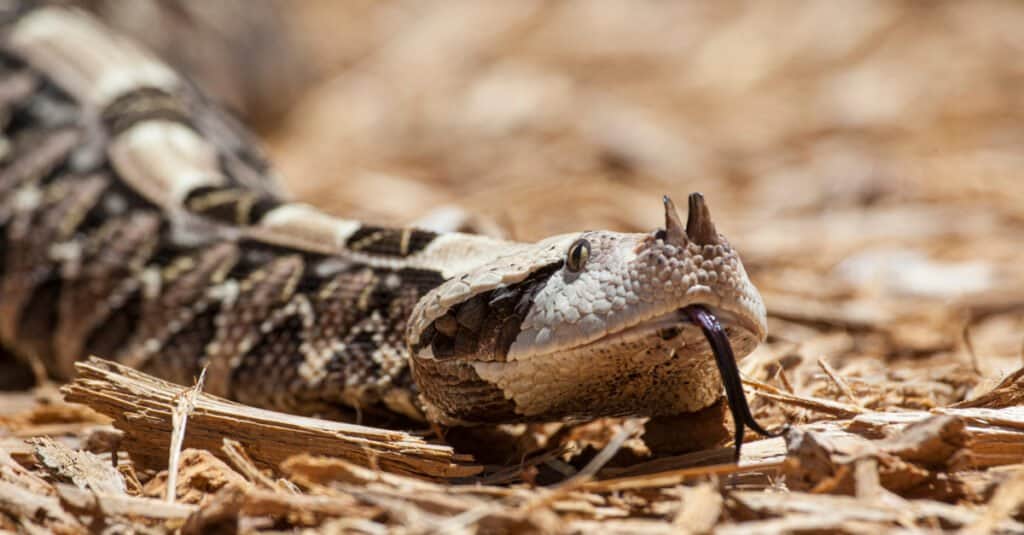
The Gaboon viper is
Africa
‘s largest viper.
©Danita Delimont/Shutterstock.com
One of the largest venomous snakes on the planet, this snake is known for its beautiful pattern. The Gaboon viper is the world’s largest venomous snake by weight. It usually reaches a length of 4 to 7 feet and can weigh up to 45 pounds. The Gaboon viper possesses one of the fastest strikes in the snake world and, considering its vast size, one of the most venomous loads. The Gaboon viper is also Africa’s largest viper. Though the viper’s typical food consists of small animals, it has been observed to consume a fully grown royal antelope.
10. Fer-de-Lance
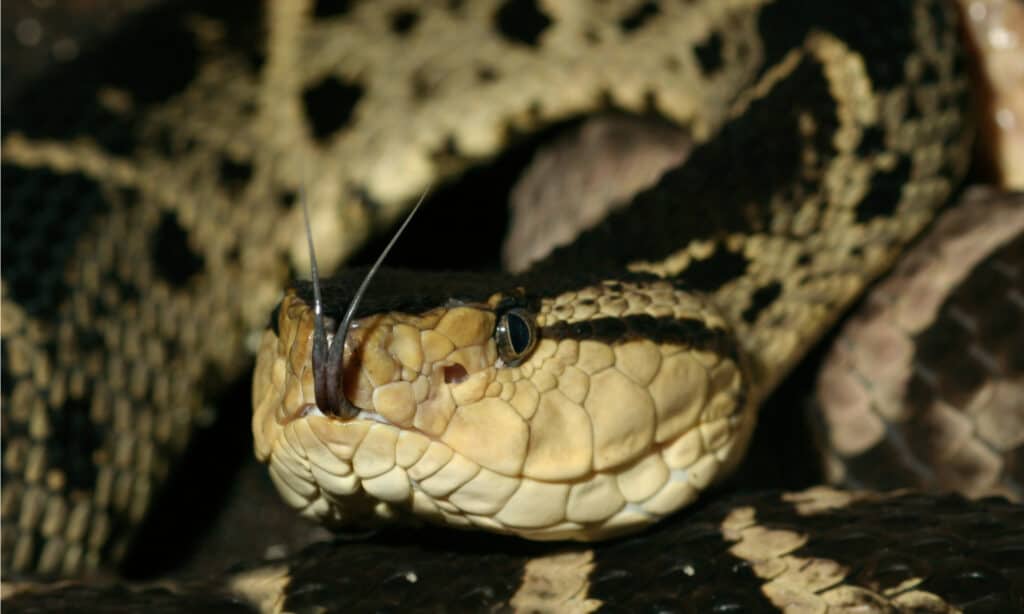
Fer-de-lances can grow more than 8 feet long.
©Mark_Kostich/Shutterstock.com
The fer-de-lance is one of South America’s largest snakes and one of the continent’s most venomous snakes and is accountable for the most snakebites. These snakes are frequently found near human settlements. Fortunately, scientists have found a highly effective anti-venom medication, and victims who are treated are more likely to live. Fer-de-lance snakes can grow to more than 8 feet in length. These snakes can be found in the tropics of South America, particularly in Venezuela and southeastern Colombia. Ecuador, Peru, Bolivia, northern Brazil, Central America, and eastern Mexico are also home to this species.
9. Banded Krait

Banded kraits can grow up to 6.6 feet long.
©RealityImages/Shutterstock.com
The banded krait is a highly venomous species closely related to the cobra. Its venom is a neurotoxin that paralyzes its victims. The Southeast Asian banded krait can grow 6.6 feet (2 meters) long, while other species can grow more than a 3.2 feet long. The bodies of all of them feature a robust triangular cross-section. The snake’s scales are smooth and shiny, and the vertebral ridge is evident.
8. Eastern Brown Snake

Eastern brown snakes are Australia’s most deadly snakes.
©Ken Griffiths/Shutterstock.com
The eastern brown snake can attack quickly and deliver a lethal dosage of venom. These snakes can be found in Australia’s arid regions. They can thrive at high altitudes and are frequently attracted to farms. The eastern brown snake is a slim snake ranging from 4.9 to 6.6 feet, with some reaching up to 7 feet. They are considered Australia’s most deadly snakes. That’s saying a lot, considering Australia’s spiders, snakes, and other critters frequently make it to the lists of deadliest animals. Despite their toxicity, these serpents rarely come into contact with humans, making attacks extremely rare.
7. Eastern Diamondback Rattlesnake
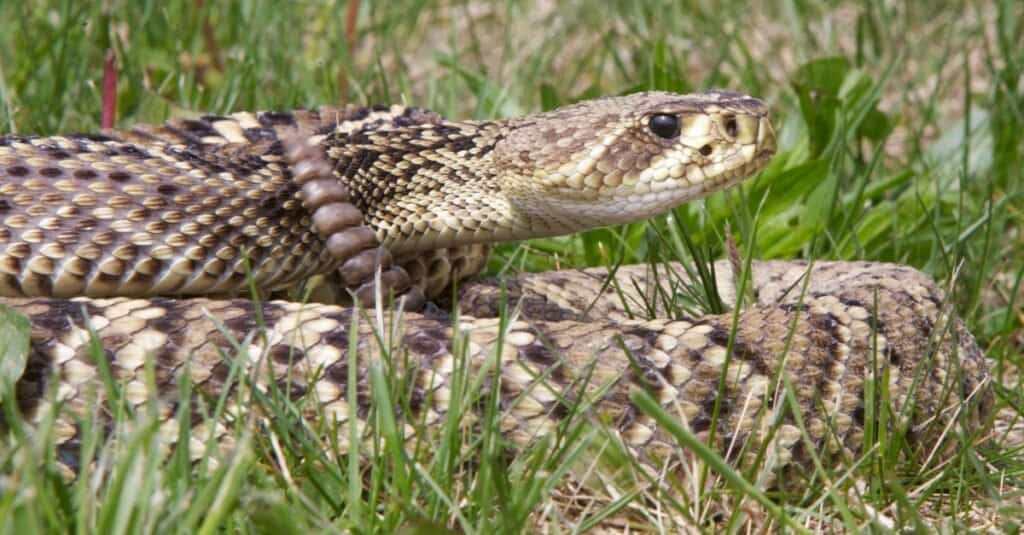
The largest rattlesnake in the world is the eastern diamondback rattlesnake.
©iStock.com/NajaShots
The eastern diamondback rattlesnake is the world’s largest rattlesnake. Adults typically range from 4 to 5 feet long and weigh between 4 and 5 pounds. A large snake can grow to be 6 feet long and weigh up to 10 pounds. The eastern diamondback rattlesnake is the longest venomous snake in North America. They’re also the world’s longest rattlesnakes, so it’s no surprise that the largest rattlesnake ever discovered was an eastern diamondback. In 1946, a hunter shot an eastern diamondback that reached 7 feet and 9 inches in length and was only given the name Rutledge in the 1982 Guinness Book of World Records. His kill weighed 34 pounds, the equivalent of four gallons of milk. Another eastern diamondback rattlesnake, measuring 7 feet 3 inches long, was caught in September 2009. The Central Florida Zoo and Botanical Gardens reported in February 2021 that it had a rattlesnake of a similar size.
6. Forest Cobra

Forest cobras reside in the woods and can swim very well.
©NickEvansKZN/Shutterstock.com
Another of Africa’s longest venomous snakes is the forest cobra. Forest cobras, like their relatives, have a distinctive hood that they will raise and flaunt when threatened. Forest cobras can reach a length of 4.6 to 7.2 feet and a weight of 4.4 to 7.9 pounds (2,000 to 3,600 grams), making them the largest true cobra. As their name implies, forest cobras reside in the woods and have been known to be incredible climbers. They can also swim extremely well and dine on fish found in woodland streams.
5. Inland Taipan
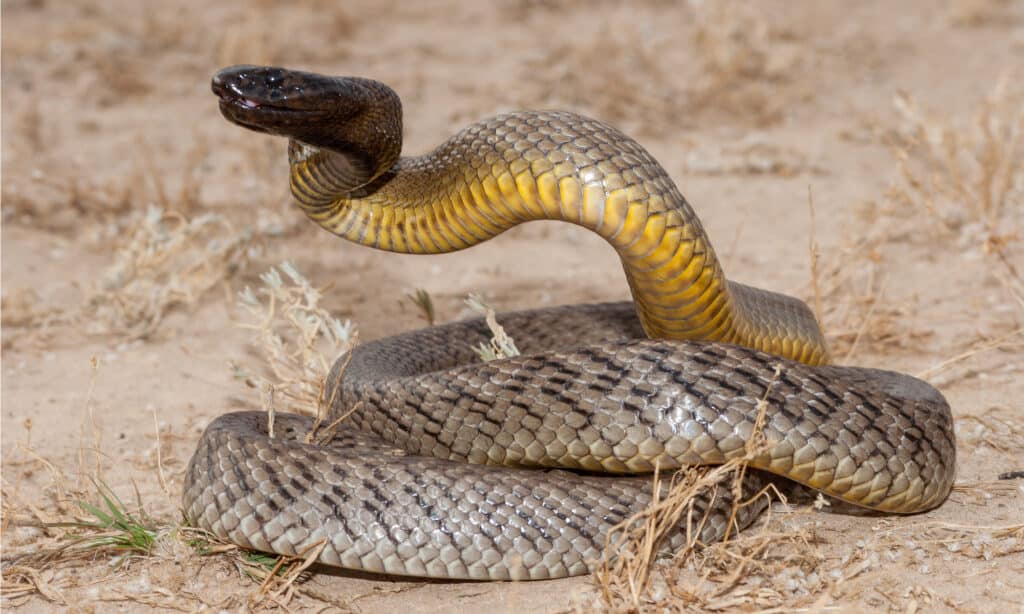
The inland taipan is considered the world’s most venomous snake.
©Ken Griffiths/Shutterstock.com
The fierce snake, also known as the inland taipan, is very venomous, and the amount of venom it delivers in a single bite is enough to kill many humans. The inland taipan averages 5.9 feet in length, while larger specimens can exceed 8.2 feet. Because they are native to Australia, the only area you can constantly find fierce snakes is there. As frightening and venomous as it is, the vicious snake is also shy. It doesn’t spend much time around humans, preferring to live in distant areas where it won’t be exposed to anyone.
4. King Brown Snake
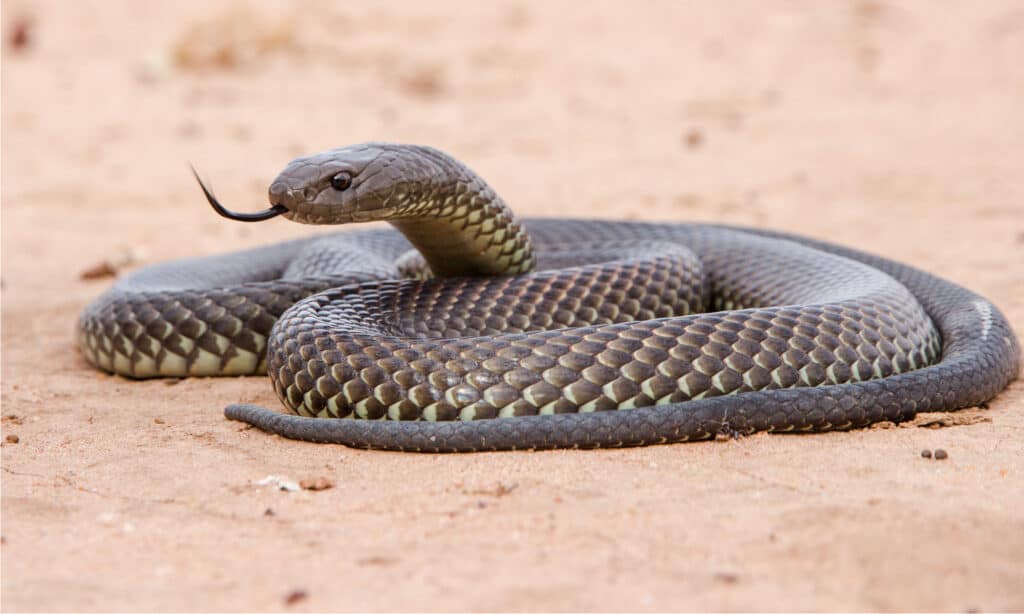
King brown snakes are Australia’s most venomous snakes.
©Ken Griffiths/Shutterstock.com
The king brown snake, Australia’s largest venomous snake, can grow 6.6 to 8.2 feet long and weigh 6.6 to 13.2 pounds, with males being roughly 20% larger than females. The biggest confirmed specimen measured 11 feet. Although one of its common names is “King brown snake,” these aren’t “genuine” brown snakes like the eastern brown snakes found in the same region. They are members of the Pseudechis genus, which includes black snakes. Their common name is derived from their brownish coloring, which varies depending on where they are in their range, as it does with many other Australian venomous snakes.
3. Bushmaster
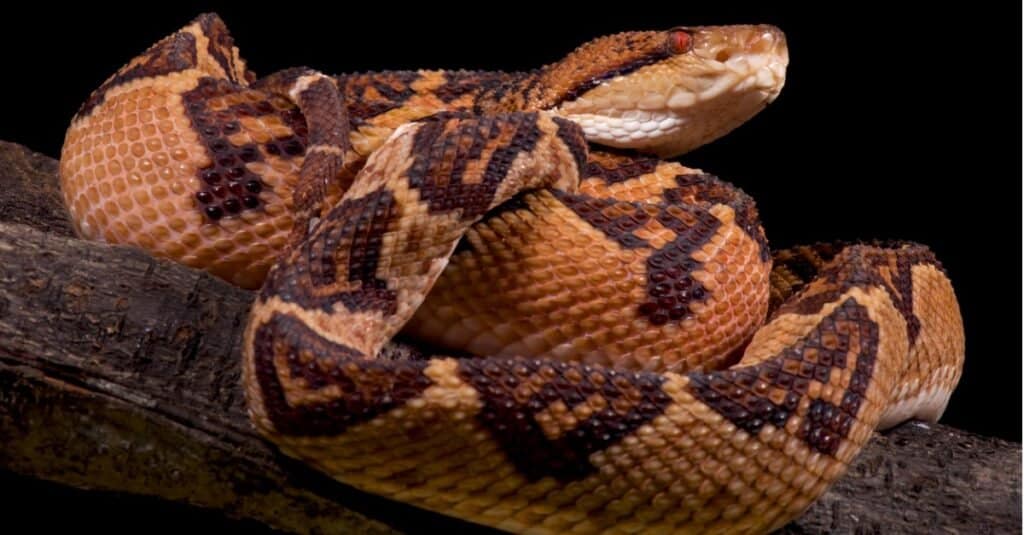
The longest pit viper in the world is the bushmaster.
©iStock.com/reptiles4all
The bushmaster is a lovely snake with dark blotches or rhomboids over lighter colored, frequently beaded scales. However, it is just as lethal as it is attractive. Adults range in length from 6.6 to 9.8 feet (2 to 3 meters), with some reaching 13 feet (4 meters), making it the Western Hemisphere’s longest venomous snake. Bushmasters are the world’s longest viper species. The South American bushmaster, specifically, is the world’s largest viper species, with the greatest specimen reaching 12 feet in length. They’re endemic to central South America and the Caribbean island of Trinidad. Bushmasters can be found in both ancient and new growth forests and near farms. They typically hunt rodents, which unfortunately draws them to regions where humans are present.
2. Black Mamba
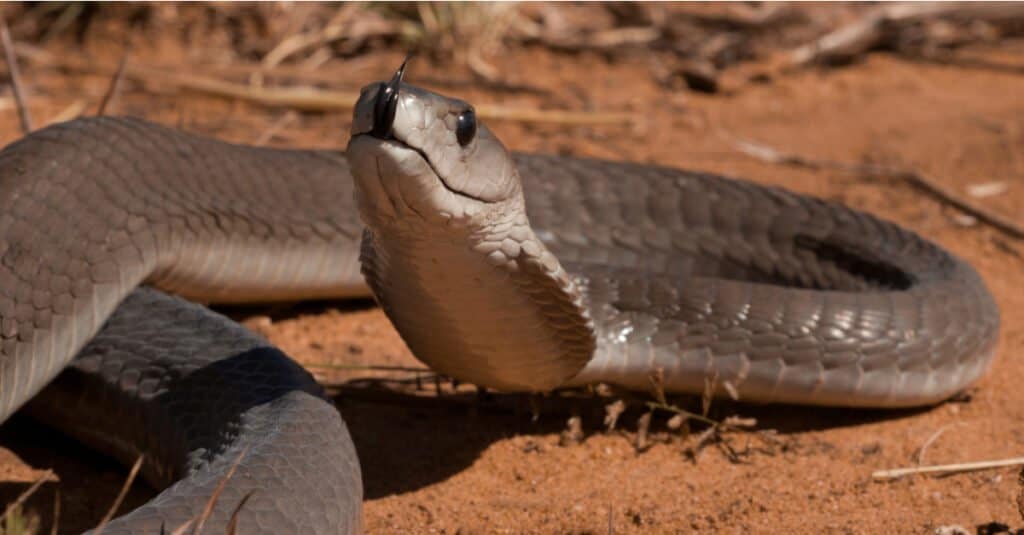
The longest venomous snake in Africa is the black mamba.
©131346563/Shutterstock.com
The black mamba is Africa’s longest venomous snake and the world’s second-longest venomous snake. Black mambas are 6.6 to 14.8 feet long and weigh an average of 3.5 pounds. Black mambas are feared throughout their range for being extremely fast and lethal. They are among the quickest snakes on land, capable of slithering at speeds of up to 12 miles per hour despite their lack of legs. The black mamba is found in sub-Saharan Africa’s south and east. It prefers to make a permanent home, which it usually does in a termite mound. These snakes are rarely black, despite their name. They’re olive, brownish-gray, or khaki instead. The majority of black mamba snakes do not reach lengths of more than 9 feet, although unusual examples of snakes reaching 15 feet have been reported.
1. King Cobra
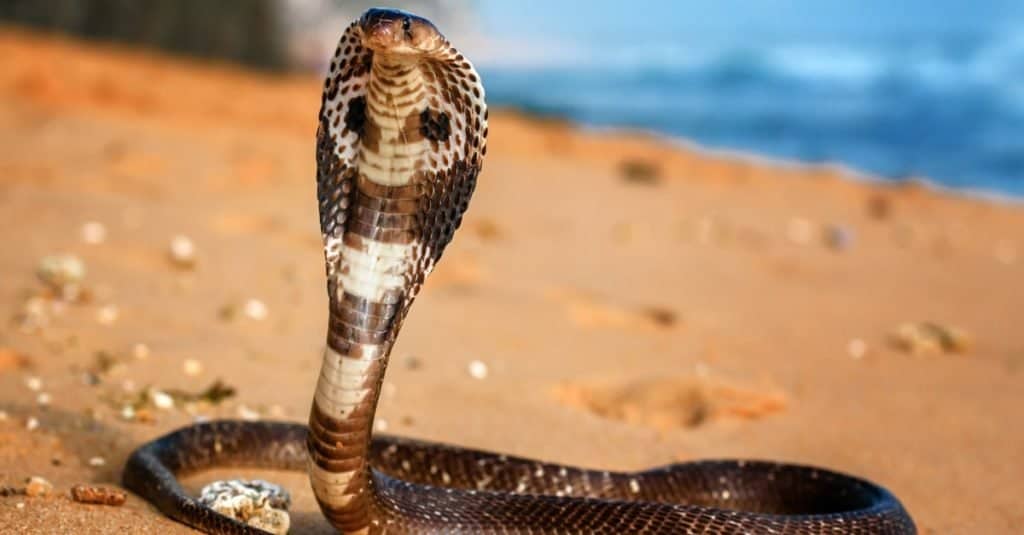
The largest venomous snake in the world is the king cobra.
©Vova Shevchuk/Shutterstock.com
King cobras are the world’s largest venomous snakes, at an average of 11 to 13 feet in length but can grow as long as 18 feet. They live in southeastern Asia, southern China, and India. Streams, woodlands, bamboo thickets, and marshes are all part of their habitat. This snake is a carnivore that feeds on snakes, birds, and lizards. In the wild, king cobras live for roughly 20 years. Their name refers to the fact that they are known to eat other snakes, including 10-foot pythons! There are no “King Cobras” on the list regarding cobra species. They are relatives of the Naja snakes, and their name translates to “snake eaters.” The world’s largest king cobra, which reached 18.8 feet in length, was discovered during World War II.
Venomous Snake Bites
Reportedly about 5.4 million people are bitten venomous snakes each year. Out of these incidents, 2.5 million result in envenomation and 125,000 deaths. Any snake bite, even seemingly by a nonvenomous species, should be taken seriously. Always try to identify the snake before medical attention to receive proper care. Always seek help from a medical professional as soon as possible.
Summary of 12 Largest Venomous Snakes
Here’s a recap of the world’s dozen biggest venomous snakes we took a look at.
| Rank | Species | Length | Location |
|---|---|---|---|
| 1 | King Cobra | Up to 18 feet | Southeastern Asia, southern China, and India |
| 2 | Black Mamba | 6.6-14.8 feet | Sub-Saharan Africa |
| 3 | Bushmaster | 6.6-13 feet | Central South America and Trinidad |
| 4 | King Brown Snake | 6.6-8.2 feet | Australia |
| 5 | Inland Taipan | 5.9-8.2 feet | Australia |
| 6 | Forest Cobra | 4.6-7.2 feet | Africa |
| 7 | Eastern Diamondback Rattlesnake | 4-6 feet | North America |
| 8 | Eastern Brown Snake | 4.9-7 feet | Australia |
| 9 | Banded Krait | Over 3.2 feet (Southeast Asian banded krait: Up to 6.6 feet) | Southeast Asia and Southern China |
| 10 | Fer-De-Lance | Over 8 feet | Venezuela, Southeastern Colombia, Ecuador, Peru, Bolivia, northern Brazil, Central America, and eastern Mexico |
| 11 | Gaboon Viper | 4-7 feet | Central and pockets of Southeastern Africa |
| 12 | Yellow Sea Snake | 3-5 feet | Northern Indian Ocean, New Caledonia, and Southeast Asia, such as the Philippines, and New Guinea |
The photo featured at the top of this post is ©
Discover the "Monster" Snake 5X Bigger than an Anaconda
Every day A-Z Animals sends out some of the most incredible facts in the world from our free newsletter. Want to discover the 10 most beautiful snakes in the world, a "snake island" where you're never more than 3 feet from danger, or a "monster" snake 5X larger than an anaconda? Then sign up right now and you'll start receiving our daily newsletter absolutely free.
Thank you for reading! Have some feedback for us? Contact the AZ Animals editorial team.






